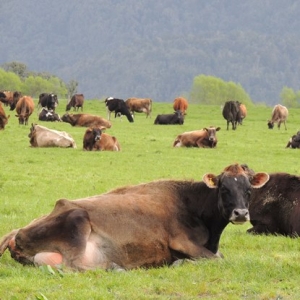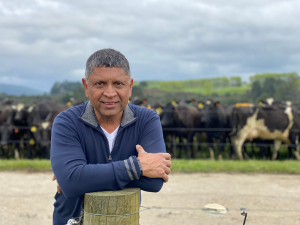The flaw, or "variation" as LIC is calling it, has been dubbed Fertility1 and is carried by about 3% of Jerseys and about 1.5% of crossbreds. It's extremely rare in Friesians, only occurring where there's an element of Jersey somewhere in the ancestry.
LIC general manager of research and development, Richard Spelman, says the variation affects fertility and calf survival. Embryos carrying double copies of the recessive gene are thought to die in utero or are stillborn.
"No live animals have been seen [exhibiting] the variation."
Analysis of stored genetics shows the trait's been in the New Zealand dairy cow population for more than 40 years with carrier sires identified from the 1970s.
The trait is recessive, so is only exhibited when both sire and dam are carriers and even then only 25% of progeny.
Spelman says LIC will genotype all of its active bulls and may still use carrier bulls where their genetic merit warrants use.
"DataMate, used by LIC AB Technicians, will issue alerts to reduce the frequency of matings between two carriers of the variation, and a genotype test will be available to farmers, wanting to test their cows, through GeneMark."
LIC says that in a Jersey herd of 400 cows there would likely be 12 carrier animals but because carrier cow has to mate with carrier bull, and even then only one if four calves are affected, it's likely only one animal per herd of 400 Jerseys will have been affected by the trait (ie missed a pregnancy or had a still born calf) in the past five years.
LIC is DNA screening its bulls for the trait and says the test will be made available to other genetics companies so they can screen their bulls.
Over time, the gene variation will be managed out of the national herd, LIC says. It doesn't know the gene's frequency in overseas genetics, but about 300 New Zealand sires from the last 30 years have been identified as possible carriers. A list of probable carriers in LIC's current stable is at the end of this article.
LIC says the DNA sequencing technology allows it to map and compare the DNA profiles of animals, identifying differences.
"Comparing the DNA sequence of a large number of sires has enabled LIC to identify a specific segment of DNA – one piece out of 3.2 billion – which is linked to the Fertility1 variation," says Spelman.
Fertility1 is the latest in a long line of recessive undesirable genes discovered in dairy animals around the world including CVM, BLAD, DUMPS, Brachyspina, Factor XI, Mulefoot and, more recently, Small Calf Syndrome.
LIC says the discovery of each genetic variation has led to the introduction of managed programmes which have significantly reduced them in dairy populations both internationally and in New Zealand. Its advice to farmers is to continue to record parentage of animals accurately so tools such as DATAMATE can be used to minimise the frequency of carrier to carrier matings.
The Fertility1 discovery was enabled by the sequencing dataset developed by LIC scientists and co-funded by Government through the Primary Growth Partnership.
LIC lists the following high use bulls as having been identified as carriers in "early but not definitive results": Gloaming SS Forever GR; Forbrae Taurus GR; Kirks RI Charisma ET GR; Bourkes Nimrod; Glanton Red Dante; Marivale Senator; Baylea Brass Albert; Deercrest Glenduan; SR Jellymans Atlanta; Lostahill Forevers Blake; William Ace of Hearts; Errlyn SS Pride GR; Kokofu Peppermint; SRB Newstead Governor; Priests Solaris ET; Williams TGM Henry; Harveys Zachary; Rockhaven Forever Sam; Marsden Red Athol; Howies Conqueror; Priests Brigadier; St Peters Obsidian; Puketawa Mins Supernova; Howies Easyrider; McDonalds Tweed ET; Ewings Ebony; Keystone HE Orpheus; Crescent AMC Marvel; Lynbrook Opium Trail; Marsden PMS Jade; Lynbrook Super Trickster; Lynbrook HTA Trifecta ET; Kerstens KRC Ronaldo; Tawa Grove KRC Tana; Colfols Crikey; Bells Solaris Perry; Howies Arkan Ramada ET; Scotts Bravo ET.
DNA SEQUENCING has identified another genetic flaw in dairy cattle, this time coming from the Jersey side of the industry.
Popular Reads
MPI launches industry-wide project to manage feral deer
An industry-wide project led by Ministry for Primary Industries (MPI) is underway to deal with the rising number of feral…Early drought fears ease in Hawke’s Bay, but caution remains
Fears of a serious early drought in Hawke’s Bay have been allayed – for the moment at least.Fonterra shareholders watch performance after sale
Fonterra shareholders say they will be keeping an eye on their co-operative's performance after the sale of its consumer businesses.Idea of killing cows to curtail methane emissions 'crazy'
Visiting US climate change expert Dr Will Happer says the idea of reducing cow numbers to greatly reduce methane emissions…Featured
Indian FTA 'opens doors for dairy'
A New Zealand dairy industry leader believes the free trade deal announced with India delivers wins for the sector.
Coalition Govt split over Indian FTA
The Coalition Government will need the support of at least one opposition party to ratify the free trade deal with India.
Santa's present for the primary sector - an FTA with India
Primary sector leaders have welcomed the announcement of a Free Trade Agreement between India and New Zealand.
Beef Progeny Test 2025: Genetic insights for NZ beef industry
At Pāmu’s Kepler Farm in Manapouri, mating has wrapped up at the across-breed Beef Progeny Test.
HortNZ celebrates 20 Years
More than 150 people turned up at Parliament recently to celebrate the 20th anniversary of Horticulture New Zealand (HortNZ).
Biosecurity NZ urges vigilance for yellow-legged hornets
Biosecurity New Zealand says Kiwis should continue to keep an eye out for yellow-legged hornets (Vespa velutina) over the holiday season.
National
Fonterra capital return could boost GDP – ANZ Report
The Fonterra divestment capital return should provide “a tailwind to GDP growth” next year, according to a new ANZ NZ report,…Fonterra upgrades Eltham cheese production for global growth
Fonterra's Eltham site in Taranaki is stepping up its global impact with an upgrade to its processed cheese production lines,…Michelle Pye elected to Fonterra board
Canterbury farmer Michelle Pye has been elected to Fonterra’s board for a three-year term.Government plan to scrap regional councils faces criticism
Government plans to get rid of regional councillors shows a lack of understanding of the fundamental problem affecting all of…Lactose to join fat and protein in Fonterra milk price model
For over 20 years, Whakatane farmer Gerard Van Beek has been attending Fonterra annual general meetings with the same message…Machinery & Products
Case IH Unveils New RB6 Round Balers & 2026 Square Baler Upgrades
Case IH has released details of its all-new round balers and redesigns to its large square balers aimed at increasing…How to Improve Milking Efficiency in Swing-Over Herringbone Sheds
The swing-over herringbone is the most common dairy type in New Zealand, used on 69% of dairy farms. Simple changes…Claas Jaguar 1000 Series sets new forage harvesting world record
The recently released Claas Jaguar 1000 Series has seen its flagship 1200 set a new official Guiness World Record in…CB Norwood appoints John Skurr as new general manager
CB Norwood Distributors Limited has announced the appointment of John Skurr to the position of general manager.AIMER, Bovonic and Herd-i join forces to advance NZ dairy tech
Three New Zealand agritech companies are set to join forces to help unlock the full potential of technology.» Latest Print Issues Online
Milking It
Trump's tariffs
President Donald Trump’s decision to impose tariffs on imports into the US is doing good things for global trade, according…
Tanker on the roll
Seen a giant cheese roll rolling along Southland’s roads?
















